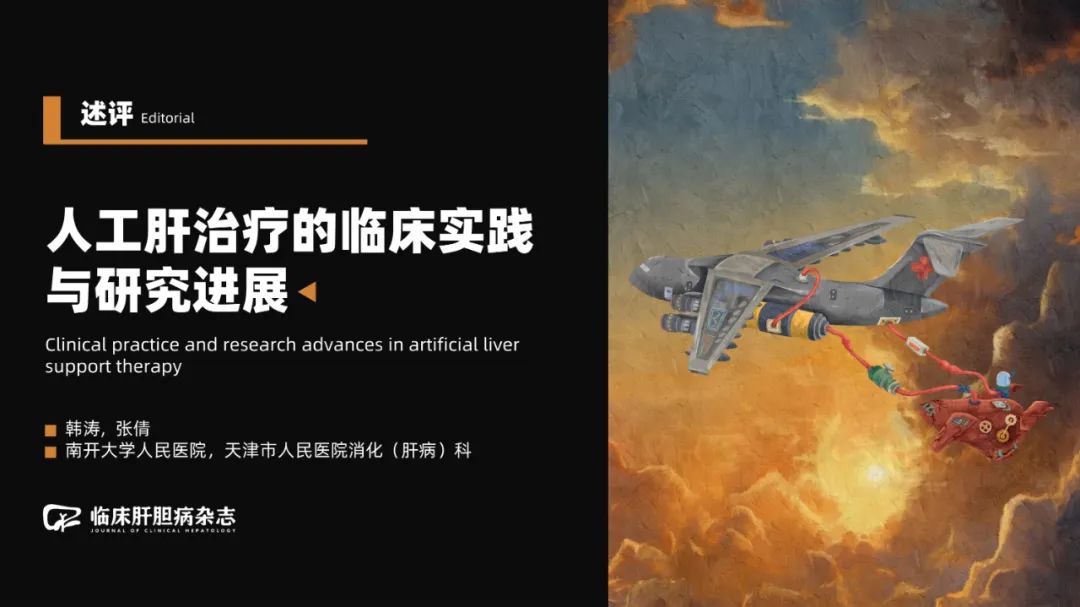

Hepatic failure is a common critical condition caused by severe liver dysfunction, particularly acute (subacute) liver failure and subacute liver failure, which progress rapidly and have a high mortality rate. The basic principle of the artificial liver support system is to temporarily replace part of the liver’s function through extracorporeal mechanical, physicochemical, and biological devices, effectively removing harmful toxins and inflammatory mediators from the body of patients with liver failure, supplementing essential substances such as albumin and coagulation factors, and improving the disrupted internal environment, thereby creating conditions for liver cell regeneration, liver function recovery, or liver transplantation. The types of artificial liver can be divided into non-biological, biological, and hybrid types. Among them, the non-biological artificial liver (NBAL) has made significant advances in terms of equipment, treatment modes, and clinical research in recent years, and is currently the most widely used type of artificial liver in clinical practice. Additionally, in recent years, significant progress has been made in key technologies related to biological artificial liver (BAL), including seed cells and bioreactors, showing promising prospects.

1Research Progress of NBAL
With the continuous advancement of artificial liver technology and the increasing evidence from evidence-based medicine, the important role of NBAL in the treatment of liver failure is increasingly recognized. The “Expert Consensus on Clinical Application of Artificial Liver Blood Purification Technology (2022 Edition)” formulated in our country is of great significance for standardizing and popularizing this technology, further improving the treatment level of liver failure. Scholars abroad have also gradually recognized the role of artificial liver technology and published relevant expert consensus. The “Guidelines for the Diagnosis and Treatment of Liver Failure (2018 Edition)” in our country fully affirms the role of NBAL, especially in the treatment of early and mid-stage liver failure. In recent years, although foreign clinical guidelines related to liver failure have differing recommendations on whether artificial liver can improve patient survival rates, most agree that it has a certain improvement effect on biochemical and inflammatory indicators and the severity of hepatic encephalopathy. The consensus updated by the Asia-Pacific Association for the Study of the Liver in 2019 recommended the application of plasma exchange-based NBAL for subacute liver failure. The clinical guidelines for subacute liver failure proposed by the European Association for the Study of the Liver in 2023 stated that, except for clinical trials, routine use of NBAL or BAL is not recommended, but it also pointed out that albumin dialysis can improve the severity of hepatic encephalopathy, and therapeutic plasma exchange has potential benefits in acute liver failure and subacute liver failure. The differences in the above recommendations reflect, on one hand, the complexity of liver failure and the difficulty and challenges of conducting high-quality clinical trials for such critically ill patients; on the other hand, it also reflects certain differences in the diagnostic standards for liver failure and the application of artificial liver technology between the East and the West. Our country has developed various artificial liver technologies including plasma exchange and non-plasma methods, while molecular adsorption recirculation systems and Prometheus systems are more commonly used in some European countries. Taking subacute liver failure as an example, there are certain differences in the diagnostic criteria for subacute liver failure between the East and the West, and the clinical characteristics and prognosis of patients with different causes or triggers and different underlying liver diseases also vary. The heterogeneity of liver failure patients, the different types of artificial liver, treatment modes, the technical parameters of different devices, and the timing of treatment can all affect the evaluation of artificial liver efficacy and patient survival rates. Therefore, when designing and conducting clinical trials, efforts should be made to maintain the greatest possible homogeneity, and standardization is needed across multiple levels including artificial liver devices and technology, clinical diagnosis and treatment.
In addition to treating liver failure, the application of artificial liver blood purification technology is also becoming increasingly widespread in non-liver failure diseases, with expanding indications. It has been applied to conditions such as non-functioning transplanted liver, refractory pruritus caused by cholestasis, “cytokine storm” caused by various viral infections, sepsis with severe liver injury and multiple organ dysfunction, acute poisoning, and refractory severe autoimmune diseases, as well as thyroid storm, achieving good therapeutic effects. The expansion of indications in the “Expert Consensus on Clinical Application of Artificial Liver Blood Purification Technology (2022 Edition)” not only demonstrates the broad clinical application of artificial liver blood purification technology but also reflects the integration of artificial liver technology with other disciplines and therapeutic techniques.
The effectiveness of NBAL treatment is also related to the choice of intervention timing and mode. Liver failure often progresses rapidly with a poor prognosis; therefore, recent years have particularly emphasized early warning, early diagnosis, and early treatment. The “Guidelines for the Diagnosis and Treatment of Liver Failure (2018 Edition)” and the “Expert Consensus on Clinical Application of Artificial Liver Blood Purification Technology (2022 Edition)” both emphasize the timing of artificial liver intervention, showing better efficacy for early, mid-stage, and late-stage liver failure patients. Implementing artificial liver treatment for late-stage patients has many complications, requiring a careful weighing of risks and benefits. Currently, the commonly used NBAL treatment modes include plasma exchange/selective plasma exchange, plasma dialysis filtration, blood perfusion/plasma perfusion, dual plasma molecular adsorption systems, molecular adsorption recirculation systems, and Prometheus systems. The above artificial liver modes each have their characteristics, with different therapeutic principles and indications, and each has certain advantages, disadvantages, or limitations. Effectively combining different treatment modes has become a hot topic and development trend in both domestic and foreign research. Currently, the main NBAL combination modes used clinically include combination therapy (such as plasma dialysis filtration, molecular adsorption recirculation systems, etc.), sequential therapy (different modes performed in succession), and combined therapy (different modes performed simultaneously, such as dual plasma molecular adsorption systems + plasma exchange, etc.). Future exploration of how to effectively combine NBAL with BAL is also a question worth investigating. When implementing in clinical practice, it is necessary to base decisions on the pathophysiological mechanisms of the disease, while also considering various factors such as the clinical characteristics of the patient, the characteristics of the artificial liver treatment mode, the actual equipment and personnel conditions, the available plasma volume, and the patient’s economic situation, to reasonably select the timing, treatment mode, frequency, and intervals of artificial liver interventions, and to pay attention to dynamic assessment to continuously optimize treatment plans, maximizing patient benefits. In addition, in recent years, some key technical elements of NBAL, such as membranes, resins, artificial conduits, and new anticoagulant drugs or methods, as well as intelligent devices, have made significant progress, and professional training for personnel has been continuously strengthened. Some new NBAL technologies have shown good safety and efficacy in preliminary clinical trials. The DIALIVE liver dialysis device can adsorb endotoxins and inflammatory factors, remove dysfunctional albumin, and replace it with an equal amount of albumin. Preliminary clinical trials in patients with alcoholic liver disease-related subacute liver failure found that this device has good safety and can improve the prognosis scores and pathophysiological-related biomarkers of patients with subacute liver failure, but there was no significant improvement in survival rates compared to the standard treatment group, necessitating further studies with larger samples to confirm its safety and efficacy.

2Research Progress of BAL
BAL mainly consists of liver seed cells, bioreactors, and auxiliary circulation devices. Its basic principle is to exchange substances between the patient’s plasma and the liver cells in the bioreactor through extracorporeal circulation, functioning more similarly to human liver cells, with detoxification, synthesis, metabolism, and biotransformation capabilities, capable of temporarily replacing liver function. In recent years, significant progress has been made in key technologies related to seed cell sources, culture expansion, and bioreactors. The core element of BAL is to obtain safe, well-functioning, and sufficiently numerous liver cells. Currently, liver seed cells mainly come from porcine liver cells, tumor-derived cells, human primary liver cells, liver progenitor cells, immortalized liver cells, stem cells, and reprogrammed liver-like cells. Commonly used bioreactors primarily consist of hollow fiber reactors, microcarriers, or fiber scaffold reactors, constructing a 3D culture environment through carrier suspension or scaffold adherence, which aids in the culture and expansion of seed cells. Research centers in China and abroad have successively developed BAL, some of which have entered clinical trial stages. Professor Yan Hexin’s team transformed human primary liver cells into proliferative liver progenitor-like cells (HepLPC) in vitro and established immortalized HepLPC (iHepLPC), with the constructed Aliver-BAL significantly improving the survival rate of pigs with acute liver failure. Professor Hui Lijian’s team transdifferentiated fibroblasts into human-derived liver-like cells (hiHep) and constructed a hiHep-BAL system using hiHep as seed cells, which not only significantly improved the survival rate of pigs with acute liver failure but was also preliminarily applied in patients undergoing extensive liver resection, with small sample results showing good safety and efficacy. Although some key technologies of BAL have matured, issues such as maintaining the long-term stability of liver seed cell functions, further improving the efficacy and safety of BAL, and whether BAL can completely replace normal liver function remain to be resolved.

3Conclusion
Currently, the role of NBAL in the treatment of liver failure is increasingly recognized, with expanding indications. Clinically, it is necessary to comprehensively consider various factors to reasonably select the timing and mode of artificial liver treatment. Standardized, individualized, and precise treatment and the optimized combination of different modes are trends in the clinical application of artificial liver. Currently, some key technologies of BAL are becoming increasingly refined, and some have entered clinical trials, warranting further attention. Despite significant progress in the field of artificial liver treatment in recent years, many challenges remain. Issues such as how to improve the efficacy and safety of artificial liver through technological innovation and optimized combinations, and how to design and conduct high-quality clinical trials to obtain higher-level evidence-based medicine need to be urgently addressed. At the same time, we also look forward to future interdisciplinary and interdepartmental collaborative efforts, effective cooperation across multiple links and the entire chain of production, learning, and research, to further accelerate the development and transformation of new artificial livers, thereby improving the treatment level of liver failure.

https://www.lcgdbzz.org/cn/article/doi/10.12449/JCH240201

Han Tao, Zhang Qian. Clinical Practice and Research Progress of Artificial Liver Treatment[J]. Clinical Hepatology and Biliary Disease Journal, 2024, 40(2): 225-228


The first release on the entire network|The “Clinical Hepatology and Biliary Disease Journal” 2024 Issue 2 “Clinical Practice and Research Progress of Artificial Liver Treatment” key issue (executive editor: Han Tao)

Riding the Waves to Write Glory——The 2024 Chief Editor’s Message from the “Clinical Hepatology and Biliary Disease Journal”

Key Topics and Executive Editors of the “Clinical Hepatology and Biliary Disease Journal” 2024 Issues 1-10

■ The first professional journal for liver and biliary diseases in China
■ Indexing in 13 major international databases
■ One of the top 100 academic journals in China
■ A premium science and technology journal in China
■ One of the top 100 science and technology journals in China
■ Included in the “World Influence Index Report on Scientific Journals”
■ A core journal in Chinese University Library
■ A statistical source journal for Chinese scientific papers
■ RCCSE Chinese Core Academic Journal
Official website:lcgdbzz.org
Official WeChat:lcgdbzz1985
Submission Inquiry:0431-88782044
Review Inquiry:0431-88783542
Review Expert Application Portal:Click to View